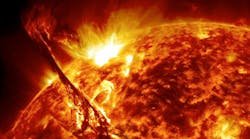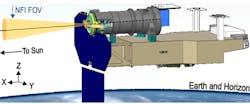Navy Launches Satellites to Study Solar Flares
U.S. Naval Research Laboratory researchers are partnering with Southwest Research Institute (SwRI) to shine a light on the effect of the solar atmosphere on the interplanetary medium between the Earth and the Sun.
NASA is funding much of the effort for this Polarimeter to Unify the Corona and Heliosphere (Punch) program. The mission is to study the Sun’s outer corona. By studying this interplanetary medium, researchers gain a better understanding of how solar events effect Earth’s atmosphere and magnetic field.
“This mission really has two focuses,” said Robin Colaninno, Ph.D., an astrophysicist with NRL’s Space Science Division. “Trying to look at the creation of the solar wind from the corona and then also looking at the propagation of the coronal mass ejections in the solar wind.”
U.S. Naval Research Laboratory’s Narrow Field Imager shown on one of the four Punch micro-satellites. Punch will provide imagesof the solar wind from low Earth orbit. Work was funded by NASA. (Graphic courtesy of Punch Team)
Space-based observatories typically involve just one spacecraft, but Punch will consist of a constellation of four suitcase-sized microsatellites. From low earth orbit, researchers will have an unprecedented wide view of the solar wind in three dimensions. Punch will also use much of the data being collected by NASA’s Parker Solar Probe mission, which is currently orbiting the Sun closer than any previous spacecraft.
Instruments designed to look at the side of the Sun will be aboard three of the miniaturized satellites. The fourth satellite will carry NRL’s Narrow Field Imager (NFI). This compact coronagraph will look at the outer region of the solar atmosphere.
Colaninno said NRL’s long history in solar physics makes the facility uniquely suited to building the instrument.
“With increased technology and with our ability to model these systems,” Colaninno said. “We can improve the way the coronagraph works and design them so that we are getting the most out of it.”
The Punch mission is part of NASA’s Heliophysics Small Explorers Program, which seeks to find small, low-cost initiatives to study the universe. Punch is scheduled to launch on a Pegasus rocket as early as 2022.


